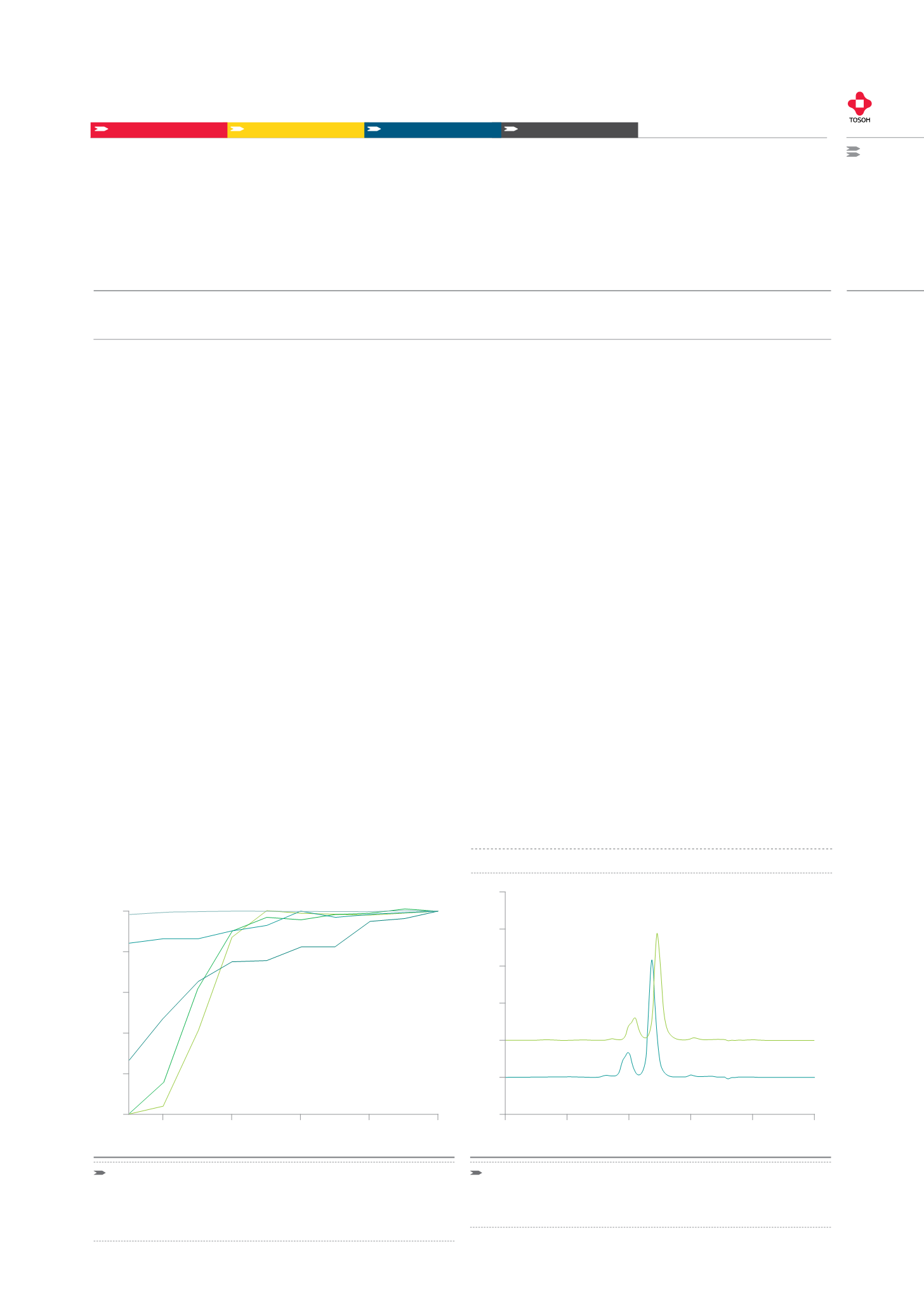
Recently, various approaches to improve analytical SEC have focused
on reducing the analysis time. This can be achieved by staggered
injection protocols or increased linear flow rates. The mobile phase
composition itself leaves less room for method improvement,
compared to other chromatographic modes. As soon as a certain
ionic strength (inhibiting electrostatic interactions without causing
hydrophobic interactions) and the pH of the mobile phase (ensuring
structural integrity of proteins and the stationary phase) are set, one
might think that the analysis solely depends on the particle size,
packing quality and column length. However, the mobile phase
composition is not at the end of its rope, in case the mentioned para-
meters have been set. For example, arginine and other amino acids
can be added to the mobile phase to affect the aggregate recovery
in SEC.
A mAb was aggregated by incubation at 75 °C for 5 min. Subsequently,
the sample was analyzed with virgin TSKgel UltraSW Aggregate
Columns (7.8 mm ID x 30 cm) with different mobile phases. 0.2 M
lysine, arginine, proline, glutamine or sodium sulfate were added to
0.1 M sodium phosphate buffer, pH 6.7, respectively. A flow rate of
1 mL/min was applied, 20 µl (100 µg) of the aggregated mAb sample
were injected onto equilibrated columns. The figure below illustrates
the results on aggregate recovery. Glutamine and proline show a
similar behavior: the aggregates are hardly recovered for the first two
injections, while the aggregate peak suddenly appears for injection #3
and #4. The rise is not as sudden for sodium sulfate, but the aggregate
peak will only achieve its full size for injection #10. In opposition to
these results, lysine shows an even improved aggregate recovery
compared to arginine. The inter-injection variability is low, depicting
the complete aggregate content for all of the injections.
Besides aggregate recovery, resolution of the different sample com-
ponents, namely the monomer and the different aggregates, is crucial
for accurate analysis. Clearly, there is motivation to increase resolution.
The figure below depicts the separation profile of an aggregated mAb
sample on TSKgel UltraSW Aggregate using 0.1 M sodium phosphate
buffer, pH 6.7 with an addition of 0.2 M arginine. 10 Injections with
the arginine buffer were followed by 10 injections applying sodium
phosphate buffer with an addition of 0.2 M sodium sulfate, in order
to compare the two buffers. Monomer aggregate resolution, as well
as monomer fragment resolution is slightly improved for the amino
acid buffer.
Besides arginine, also proline and glutamine provide slightly
increased monomer aggregate resolution. For arginine, the fragment
monomer resolution is also improved. Although these increases in
resolution are not drastic, they confirm that increased resolution due
to the use of an advanced mobile phase is possible and that mobile
phase testing can contribute to a more reliable and robust aggregate
analysis.
Tosoh
customer magazine
A toolbox of amino acids for mAb separations
05
SEC
Application
Size exclusion chromatography (SEC) is well established for mAb aggregate analysis. As the technique has been
used since the early days of monoclonal antibody (mAb) development for pharmaceutical purposes, various method
improvements have evolved. For instance, the benefits of arginine on analytical SEC of mAb aggregate samples are
well-known. A new application note shows how SEC of mAb aggregate samples may take advantage of other amino
acid additives in the mobile phase.
Aggregate Recovery on New TSKgel UltraSW Aggregate Columns
The mobile phases contain different amino acids: lysine, arginine, prolin and glutamine.
Sodium sulfate instead of an amino acid was added as a reference. Lysine and arginine
allow almost complete aggregate recovery starting with injection #1, while proline
and glutamine lead to reduced aggregate recovery compared to sodium sulfate.
Separation profile of an aggregated mAb sample
Mobile phase: 0.1 M sodium phosphate buffer containing 0.2 M arginine. After
10 injections, the mobile phase was switched to sodium phosphate buffer with an
addition of 0.2 M sodium sulfate. For both mobile phases, injection #10 is shown.
# injection
aggregate recovery [%]
0
6
8
4
2
20
40
60
80
100
10
L-lysine
L-arginine
sodium
sulfate
L-glutamine
L-proline
time [min]
uv absorbance @ 280 nm [mAU]
-20
10
12
8
6
0
20
40
60
100
14
arginine
sodium phosphate
after arginine
aggregates
monomer
fragment
4
80
check out OUR WEBSITE
TO DOWNLOAD THE FULL LENGTH APPLICATION NOTE.


